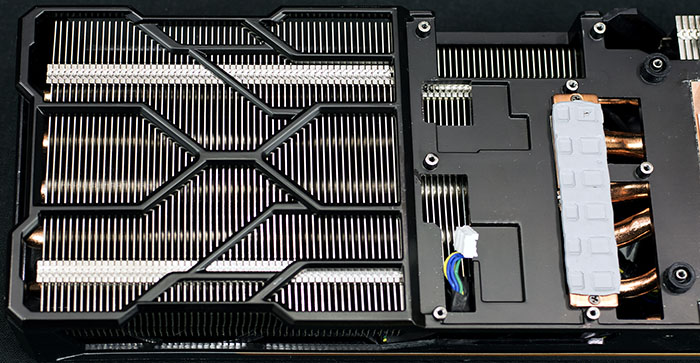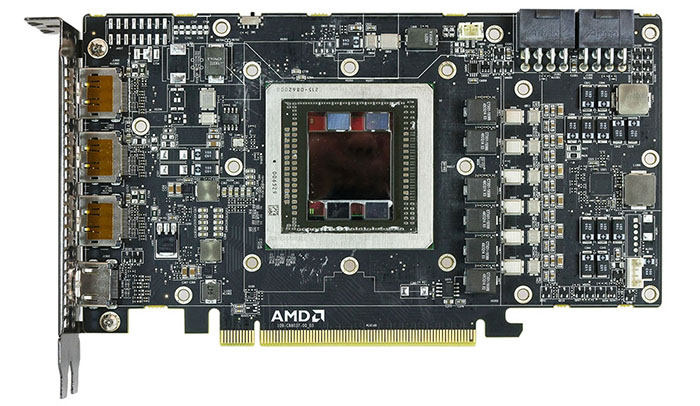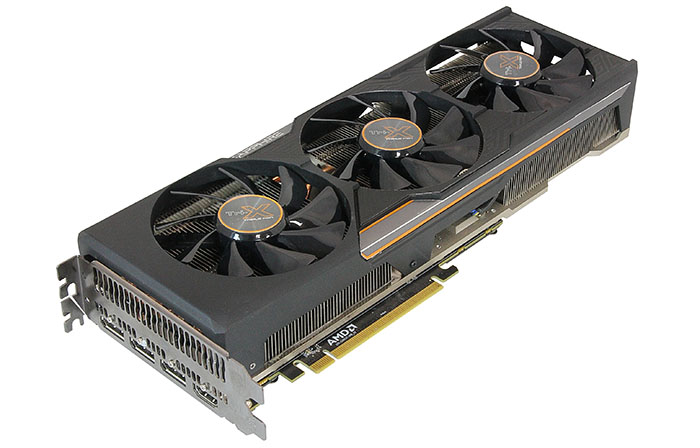The card
Understanding that the air-cooled Fury card has a 275W-ish TDP means that both Asus and Sapphire can use existing high-end coolers that are modified to a certain degree in order to accommodate the particular PCB layout of these itty-bitty boards.
Sapphire's solution is to go big, really big, from the off. We have already taken a look at the R9 390X Tri-X version just recently and were impressed by the cooler's ability to keep cool and relatively quiet under load.
The Fury model's cooler is very similar but not exactly the same. It retains the trio of 90mm fans that turn off completely under low load and remain that way until temperature exceeds 50°C or so. In our testing the fans remained off at all times the card wasn't engaged in gaming.
Underneath, the two-slot cooler features the same arrangement of heatpipes - 1x 10mm, 1x 8mm, 4x 6mm - that run all the way through the 12in-long heatsink. The mounting frame is, again, very solid, and the card's build quality exhibits very little flex. There's now a backplate that adds aesthetic appeal and, though it's not strictly needed, provides even more rigidity.
The key differences between the two Tri-X coolers is that the Fury model has a custom fin pattern and overhangs the 7.5in PCB by a considerable degree. The thermal pad placements are different, as well, with the VRMs closer to the core, but that is to be expected due to Fury's close grouping of HBM memory that sits alongside the GPU. A massive copper block makes good contact with the HBM-containing core that has a good dollop of thermal paste on top of it.
Strip away the cooler and frame reveals that, like the Fury X model, the PCB is reference in nature: this is the same generic board used on the watercooled card. Does the Tri-X cooler need to be quite so big when the underlying PCB is so small? The answer is probably yes, because dissipating 275W-plus of heat is better accomplished via a huge heatsink, though such an approach is at odds with AMD's small-yet-powerful Fury X theme.
Sapphire is to retail two Fury Tri-X variants. One is clocked in at reference speeds, so 1,000MHz on the core and 1,000MHz for HBM memory. The second model, dubbed Tri-X OC and in for review today, features exactly the same cooler but is qualified to run at 1,040MHz core with a reference-like 1,000MHz memory.
A couple more aspects to note. The Fury board continues to have an 8-LED indicator that notes the level of GPU activity. More importantly, Sapphire uses the two BIOS positions to offer a higher power limit for the board, with the regular, shipping one providing 300W and the second 350W - frequencies remain the same, however. It's also no surprise that powering the board are two 8-pin PCIe connectors located centrally on the far side. They're actually on the edge of the PCB, but so big is the overall cooler that Sapphire has no choice other than to go with what looks like a central location.
The company does change up how the hot air is vented out of the rear. Instead of the smaller vent on the I/O panel of the R9 390X, Sapphire knows that the need not to cater for the older DVI ports allows for a full-width exhaust at the top. Below, the standard Fury X arrangement of a trio of DisplayPort 1.2a and HDMI 1.4a are in evidence.
Overall, we expect this partner-clocked card to be cool and quiet. The OC version should retail for about £450 thus putting it between the GeForce GTX 980 and GTX 980 Ti models from the competition.













